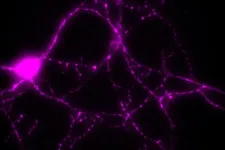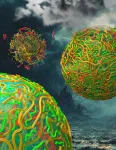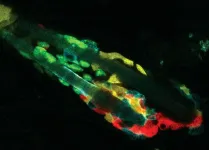(Press-News.org) Researchers at Stanford and Colorado State University have developed a rapid, low-cost approach for studying how individual extreme weather events have been affected by global warming. Their method, detailed in a Aug. 21 study in Science Advances, uses machine learning to determine how much global warming has contributed to heat waves in the U.S. and elsewhere in recent years. The approach proved highly accurate and could change how scientists study and predict the impact of climate change on a range of extreme weather events. The results can also help to guide climate adaptation strategies and are relevant for lawsuits that seek to collect compensation for damages caused by climate change.
“We’ve seen the impacts that extreme weather events can have on human health, infrastructure, and ecosystems,” said study lead author Jared Trok, a PhD student in Earth system science at the Stanford Doerr School of Sustainability. “To design effective solutions, we need to better understand the extent to which global warming drives changes in these extreme events.”
Trok and his co-authors trained AI models to predict daily maximum temperatures based on the regional weather conditions and the global mean temperature. For training the AI models, they used data from a large database of climate model simulations extending from 1850 to 2100. But once the AI models were trained and verified, the researchers used the actual weather conditions from specific real-world heat waves to predict how hot the heat waves would have been if the exact same weather conditions occurred but at different levels of global warming. They then compared these predictions at different global warming levels to estimate how climate change influenced the frequency and severity of historical weather events.
Case studies and beyond
The researchers first put their AI method to work analyzing the 2023 Texas heat wave, which contributed to a record number of heat-related deaths in the state that year. The team found that global warming made the historic heat wave 1.18 to 1.42 degrees Celsius (2.12 to 2.56 F) hotter than it would have been without climate change. The researchers also found that their new technique accurately predicted the magnitude of record-setting heat waves in other parts of the world, and that the results were consistent with previously published studies of those events.
Based on this, the researchers used the AI to predict how severe heat waves could become if the same weather patterns that caused previous record-breaking heat waves instead occurred under higher levels of global warming. They found that events equal to some of the worst heat waves in Europe, Russia, and India over the past 45 years could happen multiple times per decade if global temperatures reach 2.0 C above pre-industrial levels. Global warming is currently approaching 1.3 C above pre-industrial levels.
“Machine learning creates a powerful new bridge between the actual meteorological conditions that cause a specific extreme weather event and the climate models that enable us to run more generalized virtual experiments on the Earth system,” said study senior author Noah Diffenbaugh, the Kara J Foundation Professor and professor of Earth system science in the Stanford Doerr School of Sustainability. “AI hasn’t solved all the scientific challenges, but this new method is a really exciting advance that I think will get adopted for a lot of different applications.”
The new AI method addresses some limitations of existing approaches – including those previously developed at Stanford – by using actual historical weather data when predicting the effect of global warming on extreme events. It does not require expensive new climate model simulations because the AI can be trained using existing simulations. Together, these innovations will enable accurate, low-cost analyses of extreme events in more parts of the world, which is crucial for developing effective climate adaptation strategies. It also opens up new possibilities for fast, real-time analysis of the contribution of global warming to extreme weather.
The team plans to apply their method to a wider range of extreme weather events and refine the AI networks to improve their predictions, including using new approaches to quantify the full range of uncertainty in the AI predictions.
“We’ve shown that machine learning is a powerful and efficient new tool for studying the impact of global warming on historical weather events,” said Trok. “We hope that this study helps promote future research into using AI to improve our understanding of how human emissions influence extreme weather, helping us better prepare for future extreme events.”
Acknowledgement/footer box:
Diffenbaugh is also the Kimmelman Family Senior Fellow in the Stanford Woods Institute for the Environment. Co-authors of the study also include Elizabeth Barnes and Frances Davenport of Colorado State University. The study was funded by Stanford University and the U.S. Department of Energy.
END
Using AI to link heat waves to global warming
2024-08-21
ELSE PRESS RELEASES FROM THIS DATE:
The role of an energy-producing enzyme in treating Parkinson’s disease
2024-08-21
An enzyme called PGK1 has an unexpectedly critical role in the production of chemical energy in brain cells, according to a preclinical study led by researchers at Weill Cornell Medicine. The investigators found that boosting its activity may help the brain resist the energy deficits that can lead to Parkinson’s disease.
The study, published Aug. 21 in Science Advances, presented evidence that PGK1 is a “rate-limiting” enzyme in energy production in the output-signaling branches, or axons, of the dopamine neurons that are affected in Parkinson’s disease. This means that even a modest boost to PGK1 activity can have ...
Life from a drop of rain: New research suggests rainwater helped form the first protocell walls
2024-08-21
One of the major unanswered questions about the origin of life is how droplets of RNA floating around the primordial soup turned into the membrane-protected packets of life we call cells.
A new paper by engineers from the University of Chicago’s Pritzker School of Molecular Engineering (UChicago PME), the University of Houston’s Chemical Engineering Department, and biologists from the UChicago Chemistry Department, have proposed a solution.
In the paper, published today in Science Advances, UChicago PME postdoctoral researcher Aman Agrawal and his co-authors ...
Surprising mechanism for removing dead cells identified
2024-08-21
Billions of our cells die every day to make way for the growth of new ones. Most of these goners are cleaned up by phagocytes—mobile immune cells that migrate where needed to engulf problematic substances. But some dying or dead cells are consumed by their own neighbors, natural tissue cells with other primary jobs. How these cells sense the dying or dead around them has been largely unknown.
Now researchers from The Rockefeller University have shown how the sensor system operates in hair follicles, which have a well-known cycle of birth, decay, and regeneration put into motion by hair follicle stem cells (HFSCs). In a new study published in Nature, ...
UC Irvine discovery of ‘item memory’ brain cells offers new Alzheimer’s treatment target
2024-08-21
Irvine, Calif., Aug. 21, 2024 — Researchers from the University of California, Irvine have discovered the neurons responsible for “item memory,” deepening our understanding of how the brain stores and retrieves the details of “what” happened and offering a new target for treating Alzheimer’s disease.
Memories include three types of details: spatial, temporal and item, the “where, when and what” of an event. Their creation is a complex process that involves storing information based on the meanings and outcomes of different experiences and forms the foundation of our ability to recall and recount them.
The study, published ...
Study shows successful use of ChatGPT in ag education
2024-08-21
By John Lovett
University of Arkansas System Division of Agriculture
FAYETTEVILLE, Ark. — Artificial intelligence tools such as ChatGPT show promise as a useful means in agriculture to write simple computer programs for microcontrollers, according to a study published this month.
Microcontrollers are small computers that can perform tasks based on custom computer programs. They receive inputs from sensors and can be used in climate and irrigation controls, food processing systems, as well as robotic and drone applications, to name a few agricultural uses.
A recent study published with the Arkansas Agricultural ...
Early interventions may improve long-term academic achievement in young childhood brain tumor survivors
2024-08-21
(MEMPHIS, Tenn. – August 20, 2024) Children who survive a brain tumor often experience effects from both the cancer and its treatment long after therapy concludes. Scientists at St. Jude Children’s Research Hospital found very young children treated for brain tumors were less prepared for school (represented by lower academic readiness scores) compared to their peers. This gap persisted once survivors entered formal schooling. Children from families of higher socioeconomic status were partially protected from the effect, suggesting that providing early developmental resources may proactively help reduce the academic achievement gap. The findings were published today in ...
Cholecystectomy not always necessary for gallstones and abdominal pain
2024-08-21
Each year, 100,000 people visit their doctor with abdominal pain, with approximately 30,000 of them diagnosed with gallstones. The standard treatment for these patients is a laparoscopic cholecystectomy. Since the 1990s, the number of surgeries has increased exponentially, despite the lack of clear international criteria. As a result, gallbladder removal is one of the most common surgeries in the Netherlands, yet it is not always effective against pain: about one-third of patients continue to experience abdominal pain after cholecystectomy. The procedure has long been an example of inappropriate care, but this is now changing.
In a 2019 study conducted by Radboud university ...
Greenhouse gas HFC-23: Abatement of emissions is achievable
2024-08-21
Hydrofluorocarbons (HFCs) are potent greenhouse gases (GHGs). The most potent of these compounds is trifluoromethane, also known as HFC-23. One kilogram of HFC-23 in the atmosphere contributes as much to the greenhouse effect as 12,000 kilograms of CO₂. It takes around 200 years for the gas to break down in the atmosphere. For this reason, more than 150 countries have committed to significantly reducing their emissions of HFC-23 as part of the Kigali Amendment to the Montreal Protocol.
The main source of HFC-23 ...
Researchers identify most common long COVID symptoms in children and teens
2024-08-21
Aug. 21, 2024--Researchers from the NIH’s RECOVER Initiative have determined what long COVID looks like in youths, based on the most common symptoms reported in a study of over 5,300 school-age children and adolescents.
Using the findings, published today in the Journal of the American Medical Association, the researchers also created indices that contain prolonged symptoms—eight for school-age children and 10 for adolescents—that together most likely indicate long COVID.
The indices are not intended to be used in making a clinical diagnosis of long COVID but will guide research to improve diagnosis, treatment, and prevention of the condition in youths.
“Many ...
NIH-funded study finds long COVID affects adolescents differently than younger children
2024-08-21
NIH-funded study finds long COVID affects adolescents differently than younger children Adolescents were most likely to experience low energy/tiredness while children were most likely to report headache
Scientists investigating long COVID in youth found similar but distinguishable patterns between school-age children (ages 6-11 years) and adolescents (ages 12-17 years) and identified their most common symptoms. The study, supported by the National Institutes of Health (NIH) and published in JAMA, comes from research conducted through the NIH’s Researching ...




